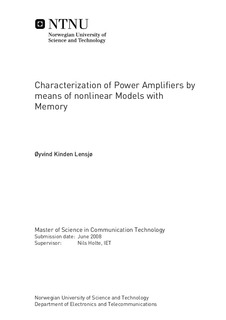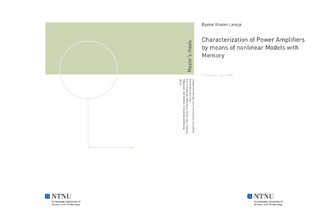| dc.contributor.advisor | Holte, Nils | nb_NO |
| dc.contributor.author | Lensjø, Øyvind Kinden | nb_NO |
| dc.date.accessioned | 2014-12-19T13:44:11Z | |
| dc.date.accessioned | 2015-12-22T11:42:01Z | |
| dc.date.available | 2014-12-19T13:44:11Z | |
| dc.date.available | 2015-12-22T11:42:01Z | |
| dc.date.created | 2010-09-04 | nb_NO |
| dc.date.issued | 2008 | nb_NO |
| dc.identifier | 348680 | nb_NO |
| dc.identifier | ntnudaim:4270 | |
| dc.identifier.uri | http://hdl.handle.net/11250/2369388 | |
| dc.description.abstract | Wireless communication systems suffer a great deal from the inherent nonlinear nature of power amplifiers. Effects such as signal distortion and spectral broadening can seriously degrade the performance of both the system at hand and neighboring ones. These problems need to be dealt with, both in the sense of mitigating them and observing the implications caused. For the case of problem mitigation, some sort of linearization of the power amplifier is needed, while simulation tools provide a way of observing the implications. Data from three different power amplifiers are used in the experiments carried out in this study. All three sets use 16-QAM modulation and have a relatively narrow bandwidth of about 190 kHz. Digital predistortion is a well known technique for linearization of power amplifiers. An important part of this technique is the modeling of the power amplifier. In this study, two different models are investigated. Both models employ cubic splines to approximate the nonlinearity. The first model is memoryless, consisting only of the spline approximation, while the second one also accounts for memory effects by inserting a linear transversal filter subsequent to the spline approximation. The models have been tested and evaluated, proving the model with memory effects to be the superior one. However, this superiority is by no means general. Radio communication simulation tools need accurate models of power amplifiers to achieve high performance. This area of modeling power amplifiers is called system-level modeling. Two empirical models have been investigated in this study, both applicable as system-level models. Both models exploit physically-based memory effects related to the RF frequency response, self-heating and the biasing network to obtain highly accurate results. The models differ only in the basis functions employed when approximating nonlinearities; the first model employs polynomials while the second one employs cubic splines. The two models have been tested and evaluated, both performing at a very high level. The empirical models presented have many degrees of freedom, and it was discovered that the optimal structure of the model depended on the power amplifier it was set to characterize. Hence, the optimal structures of the models were found not to be general. The results obtained are evaluated both in time- and frequency-domain. Problems and limitations concerning both the models themselves and the model coefficient estimation procedures are analyzed and discussed along with proposals for further work. | nb_NO |
| dc.language | eng | nb_NO |
| dc.publisher | Institutt for elektronikk og telekommunikasjon | nb_NO |
| dc.subject | ntnudaim | no_NO |
| dc.subject | SIE7 kommunikasjonsteknologi | |
| dc.subject | Signalbehandling og kommunikasjon | |
| dc.title | Characterization of Power Amplifiers by means of nonlinear Models with Memory | nb_NO |
| dc.type | Master thesis | nb_NO |
| dc.source.pagenumber | 66 | nb_NO |
| dc.contributor.department | Norges teknisk-naturvitenskapelige universitet, Fakultet for informasjonsteknologi, matematikk og elektroteknikk, Institutt for elektronikk og telekommunikasjon | nb_NO |

